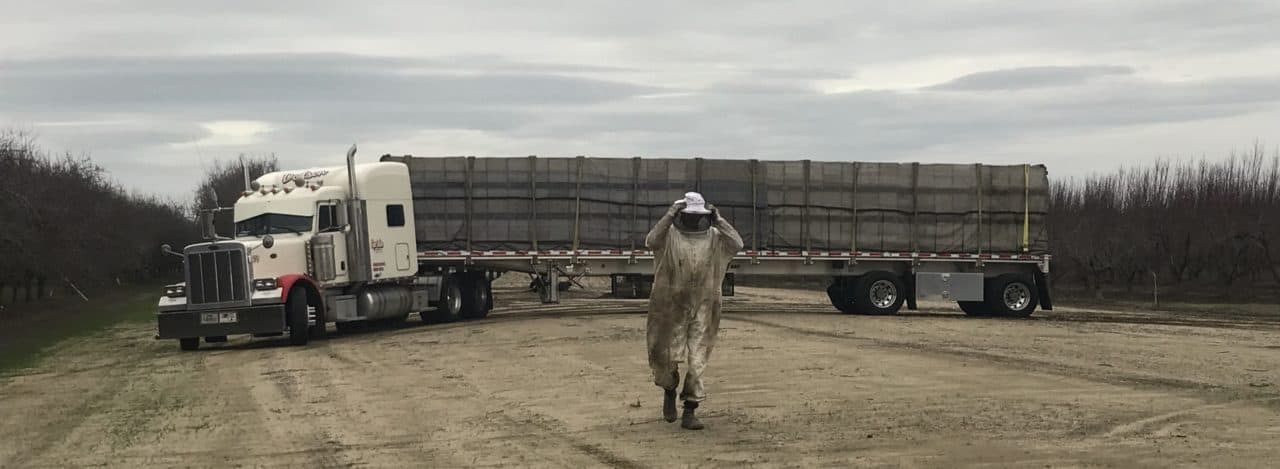Every year, beekeepers from across the continental United States move millions of honey bee colonies to California’s Central Valley, arriving just in time to tend the billions of bursting almond blossoms that require their pollination services. But have you ever really thought about what it takes to accomplish this massive migration? Colonies from every corner of the country – many hunkered down in the dead of winter, or stacked in indoor, cold storage sheds – are prepped and loaded onto semis, hauled hundreds of miles, inspected at border stations, unloaded into temporary holding yards, and then relocated once more – strategically placed amongst the almonds by beekeepers and their crews, just before bloom.
A standard semi trailer holds 102 palletes, with each pallet holding four, double-deep, ten-frame colonies. That’s 408 honey bee colonies per load (or 456 eight-frame colonies)! It takes three days to make the journey from the eastern US to California’s Central Valley. Some beekeepers choose to overwinter their colonies in California, moving them in autumn, rather than January or early February. When these bees get to California, they are unloaded into winter holding yards where they will stay until it is time to transfer them to almond orchards (Figure 1). But because of California’s relatively mild winter weather, limited forage, and high bee density, these bees will remain active, consuming more resources during this period than colonies kept in colder winter conditions. As a result, beekeepers may need to feed through the winter months.
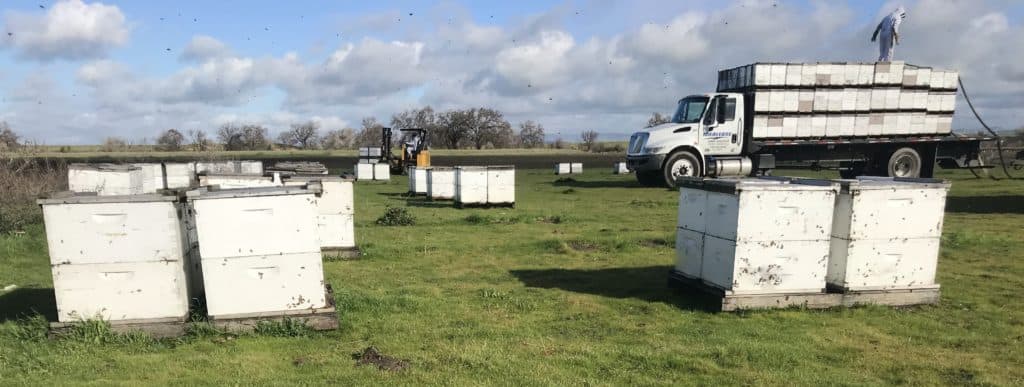
While some come in autumn, most US commercial beekeepers ship colonies to California shortly before the almond bloom. When a load arrives, the first order of business is to hop on top to remove the straps and boards. Then it’s off with their nets (Figure 2), and the emptied trailers tell the tales of those that didn’t successfully make the move (Figure 3).

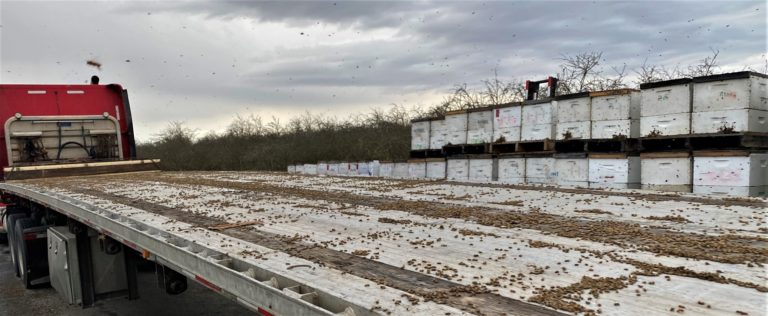
Colonies are first offloaded to temporary holding yards, where they will wait until it is time to be transferred to almond orchards. These yards can be quite crowded, holding hundreds of colonies (or more), stacked several palettes high, and often from multiple different beekeeping operations (Figure 4).
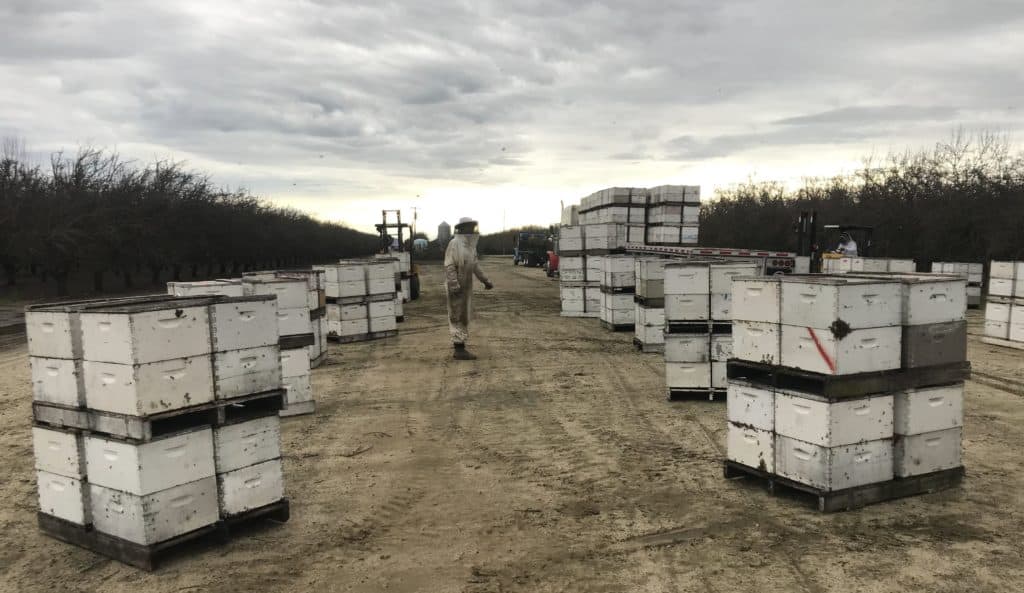
The closer it gets to bloom, activity increases to a fever pitch. Crews are working nearly nonstop – up at 5:00am to move bees, napping during the day, and then up and at it again moving more bees later that night. When transporting bees short distances, beekeepers aim to move them at dawn or dusk, or on cool, cloudy days. Under these conditions, it is light enough for workers to be able to see, but dark and/or cool enough so that the bees aren’t flying very much, negating the need to use nets or block hive entrances. They also move colonies at night when bees don’t fly, using red lights that the bees do not see, so that beekeepers can work but colonies keep calm (Figure 5).

Unfortunately, in the days and weeks leading up to almond pollination, time is in short supply. And although the worst time to move bees is during the middle of a nice day, sometimes logistics dictate that it can’t be done any other way. Bees are lost and bees are gained. Drift happens (Figure 6).
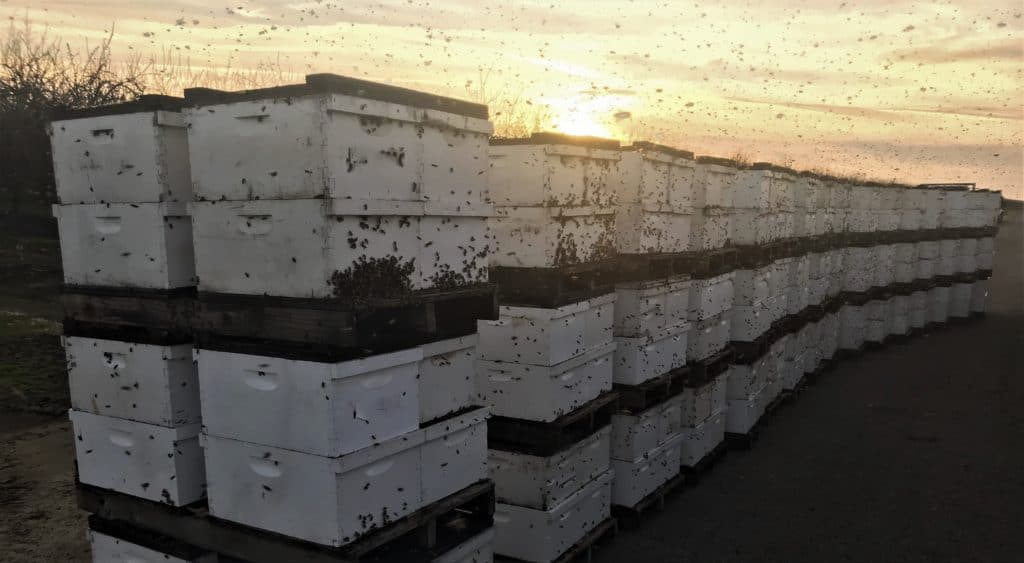
The weeks leading up to almond bloom also overlap with the valley’s brief rainy season. And if there has been a lot of rain, some orchards will be too muddy to move bees in or out. But even if it’s too wet to move colonies, beekeepers don’t get a break. There’s always work around the shop to do: assembling and repairing woodenware, preparing Varroa treatments and syrup for feeding bees, cleaning equipment, and going to the hardware store to get that one specific machine bolt you have to have so that your syrup pump won’t rattle its way off the truck every time you feed, and….
Shortly before the last petal falls and pollination services are no longer needed, the bees are ‘released’ by the grower. Beekeepers and their crews can then start moving them out. It can be more mayhem moving the bees out of almonds than it was moving them in. Most bees are released around the same time, and both beekeepers and almond growers want them out as soon as possible – after almond bloom there are not enough resources to support the density of bees, and almonds are treated with pesticides that can harm honey bees. So time is of the essence for beekeepers to once again get their crew and their colonies movin’ right along (Figure 7).

This blog was brought to you by the letters ‘M’ and ‘J’, and the number ‘1 million’
